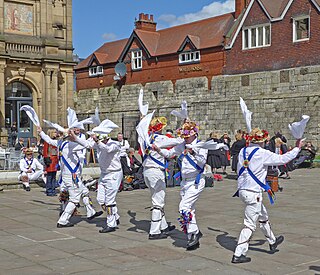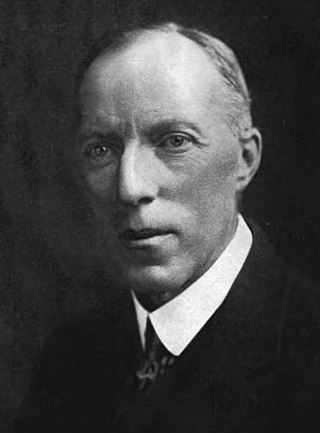
Morris dancing is a form of English folk dance. It is based on rhythmic stepping and the execution of choreographed figures by a group of dancers in costume, usually wearing bell pads on their shins and/or shoes. A band or single musician, also costumed, will accompany them. Sticks, swords, handkerchiefs, and a variety of other implements may be wielded by the dancers.

The Abbots Bromley Horn Dance is a folk dance which takes place each September in the village of Abbots Bromley in Staffordshire, England. It is performed by ten dancers, accompanied by a musician playing an accordion and a youth with a triangle. Six of the dancers carry reindeer horns; the remaining four take the roles of a hobby horse, Maid Marian, a fool, and a youth with a bow and arrow. On Wakes Monday the performers dance around the parish all day, beginning early in the morning at the parish church where the horns are stored.
Border Morris is a collection of individual local dances from villages along the English side of the Wales–England border in the counties of Herefordshire, Worcestershire and Shropshire. They are part of the Morris dance tradition.

Cecil James Sharp was an English collector of folk songs, folk dances and instrumental music, as well as a lecturer, teacher, composer and musician. He was a key figure in the folk-song revival in England during the Edwardian period. According to Roud's Folk Song in England, Sharp was the country's "single most important figure in the study of folk song and music."

Thaxted is a town and civil parish in the Uttlesford district of north-west Essex, England. The town is in the valley of the River Chelmer, not far from its source in the nearby village of Debden, and is 97 metres above sea level.

Adderbury is a winding linear village and rural civil parish about 3 miles (5 km) south of Banbury in northern Oxfordshire, England. The settlement has five sections: the new Milton Road housing Development and West Adderbury, towards the southwest; East Adderbury to the centre, with a village green and a manor house; the new housing Development on the Aynho Road; the northeast, which is known as Twyford, named after a small outlying settlement by a forked section of the River Cherwell.

William "Merry" Kimber, was an English Anglo concertina player and Morris dancer who played a key role in the twentieth century revival of Morris Dancing, a form of traditional English folk dancing. He was famous both for his concertina playing and for his fine, upright dancing, such that in his day he was presented in the highest circles of society.
The English Folk Dance and Song Society is an organisation that promotes English folk music and folk dance. EFDSS was formed in 1932 when two organisations merged: the Folk-Song Society and the English Folk Dance Society. The EFDSS, a member-based organisation, was incorporated in 1935 and became a registered charity in 1963.

Mary Neal was an English social worker, suffragette and collector of English folk dances.

Twirling is a form of object manipulation where an object is twirled by one or two hands, the fingers or by other parts of the body. Twirling practice manipulates the object in circular or near circular patterns. It can also be done indirectly by the use of another object or objects as in the case of devil stick manipulation where handsticks are used. Twirling is performed as a hobby, sport, exercise or performance.
"Country Gardens" is an old English folk tune traditionally used for Morris dancing. It was introduced by traditional folk musician William Kimber to Cecil Sharp near the beginning of the twentieth century, then popularised by a diverse range of musicians from Percy Grainger and David Stanhope to Jimmie Rodgers.
Woodside Morris are a UK Morris dance side based in Watford, Hertfordshire. The side dance Cotswold morris locally in the towns and villages around Watford, Rickmansworth, Hemel Hempstead and St Albans, and further afield at events and folk festivals across the country, as well as occasional trips abroad.
Maud Karpeles OBE, was a British collector of folksongs and dance teacher.
The Hong Kong Morris is an English morris dancing team or side founded in Hong Kong in 1974. The side now has two chapters, the Hong Kong Morris and the Hong Kong (UK) Morris, colloquially known as The Brackets, in the United Kingdom. In its heyday, in the late 1980s and early 1990s, the Hong Kong Morris was one of the largest Cotswold morris sides in the world. The side maintains that it is committed to the principles of multiculturalism and inclusivity, and has always encouraged a multicultural membership and mixed dancing. The return of the former British colony of Hong Kong to China in 1997 has had no effect on the side's activities, and it continues to flourish as a notable example of the resilience of Western cultural activity in postcolonial Hong Kong.
Icknield Way Morris Men is a Cotswold Morris Dancing team based in Wantage, Oxfordshire. As a member of the Morris Ring, Icknield Way's members are all male.

Stave dancing is a style of folk dance from the south-west of England, especially Somerset, Dorset, and Wiltshire. Teams of dancers carry long decorated poles, known as staves, over their shoulders whilst performing. Having effectively died-out in the 1920s, interest in the style revived in the 1980s, and today a number of Morris and country dancing teams perpetuate the tradition. Some claim the tradition's origins lie in the annual ‘club-walks’ of the friendly societies.

The Church of Saint John the Baptist with Our Lady and Saint Laurence is the parish church of the town of Thaxted in Essex, England. The present church was built over an extended period between c. 1380 and 1510 in the English Perpendicular style. Sitting on top of a hill with a slender spire reaching 181 feet (55 m) high, the church is one of the largest in the county, overlooking the town and the surrounding countryside. Its size is an indication of the former prosperity of the town, because of the medieval cutlery and wool trades that once flourished here. The church has earned the epithet "the Cathedral of Essex". The church is a Grade I Listed Building on the National Heritage List.
The Goathland Plough Stots are a team of Long Sword Dancers based in the village of Goathland, North Yorkshire, England. The traditional dance that they perform had died out by the start of the twentieth century but was revived in 1922. The team were expelled from the Morris Ring for allowing women to be trained in the art of the dance, the tradition being that it is a male-only dance. The Goathland Plough Stots dance is recognised as one of the oldest in England, with a history dating back more than a thousand years.
Douglas Neil Kennedy (1893–1988) was a folk musician, dancer and a key figure in the 20th century English folk dance revival.

Multiple theories exist about the origins of the theatrical practice of blackface as a caricature of black people. One interpretation is that it can be traced back to traditions connected with Morris dancing. Another interpretation is that traditionally the use of soot to blacken faces in morris dancing was derived from its use as a disguise by the poor when seeking food through begging or poaching.












